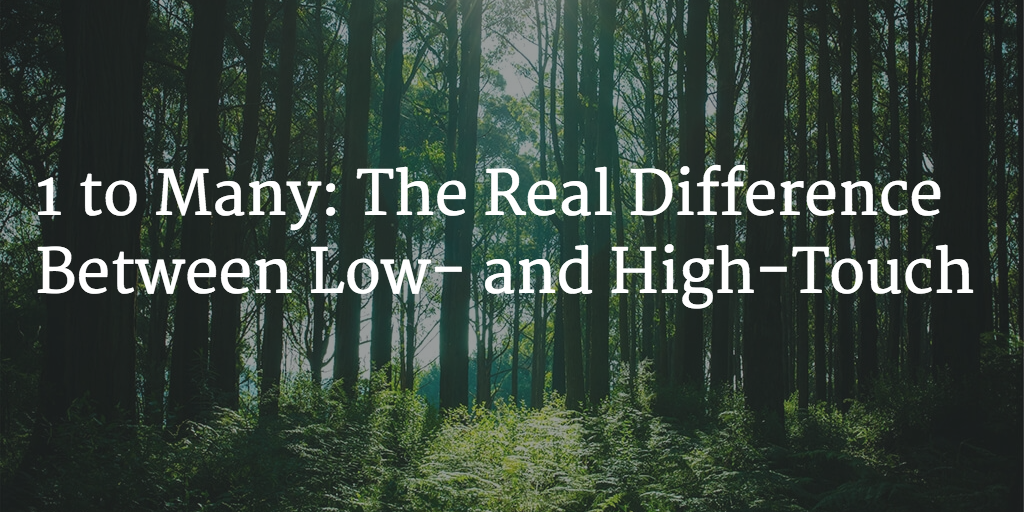If you ever attend a meetup of Customer Success professionals and want to heat-up the discussion, ask how low-touch (from a human-centric standpoint) differs from high-touch and where or if they can coexist within the same customer segment.
Then sit back and enjoy the fireworks.
This is a very contentious topic because it involves the “a” word – automation – and for many people, especially those that work more on the high-touch side of things, that is a very bad word, indeed. But it shouldn’t be.
The reality is that most companies have both high-touch and low- or tech touch customers, and while there may be a dominant customer segment, the segments should each be treated in a way that is congruent with expectations and requirements.
The Desired Outcome for each segment should dictate how you work with them, and that may require certain points of leverage to be used for the lower-revenue customer segments; but those same levers can be pulled to scale the humans working with the high-revenue customers.
1:Many is Leverage
I spend a lot of time with companies of all shapes and sizes, from high-touch enterprise-type companies to those that employ a self-service model, and the one thing I’ve always said is that leveraging automation and 1:many communication mechanisms are not just for the small, self-service companies.
1:many is just another lever you can pull to scale your ability to solve for your customer’s success.
One to many communication (aka automation, lifecycle messaging, or tech touch) is all about scale and if you want to scale – regardless of the type of company you are – building in one-to-many communication across the entire customer lifecycle will only help you scale.
Only for Low-End Customers, Right?
Contrary to popular belief, 1:many communication will help even your high-touch customers achieve their desired outcome.
Sure, maybe you wouldn’t leverage a “tech touch” model across the entire customer relationship, but I’ve never seen a situation where some level of one to many communication wouldn’t help the customer – and the people within the customer organization – do what they need to do to achieve their desired outcome, faster.
While it’s obvious that some larger customers or more strategic accounts need/deserve additional attention, the common refrain that one-to-many communications is just for small customers and not for big accounts is simply incorrect.
Only for Low-End Companies, Right?
The myth that one-to-many communication, lifecycle messaging, and the like are only for small startups is just that; a myth.
In fact, startups often fall into the trap of trying to build one to many communication – and other automation – into their workflow from day one, and then having to refactor many times as they learn about their customers, what works, and what doesn’t.
It’s actually the mature organizations that truly understand how their customers work and because of that know when they can – and can’t or shouldn’t – incorporate elements of tech touch into the mix; but they often don’t because that stuff is “just for startups.”
But is it Ethical?
If you think about it, all one to many communication is – or should be – is what we’d do manually if we had unlimited time and resources.
I’d love to sit there on my iPhone and tell each user of my expense reporting product who hasn’t turned in an expense report in the last 30 day to get on it… but I can’t, so I automate the process by messaging that cohort all at once via automation.
The common pushback around 1:many messaging is that it seems “wrong” or “unethical” to do it, especially if the emails or other message types appear – on purpose – to have come from a human. But that’s missing the point.
The Ethics of Customer Segmentation
Continuing on the theme of ethics for a moment, consider this situation:
If I have a segment of customers that are so low-revenue that it doesn’t make financial sense to manually reach out to them so I automate that process in a way that looks like I did, how can that be anything but a net positive? If they reply, I reply and we have a conversation.
They feel like someone cares (because we do), and I get to provide that level of care at scale. Win-Win.
Seems to me the unethical thing would be to ignore them and let them fend for themselves or to eliminate the pricing tier they subscribe at because it’s not economically feasible for me to interact with them at scale. But because of technology, I can… so I do.
On the flip side, I often hear from companies that have a high-touch Customer Success model where they CAN afford to manually reach out to customers and they’re deathly afraid of using automated emails in those situations because it seems “wrong.”
My response to that is simple; missing an outreach moment around a success milestone or “customer health” issue because you didn’t want to automate the process is much more unethical and disruptive to the customer.
I’d rather have an email sent to my customer – as if I did it – at the right time that moves them in the right direction or gets them to setup a time for us to talk, than miss that opportunity to help my customer be successful.
Anything Can (and Will) Be Misused
That all said, over- and misuse of automation can hurt the customer experience (if you try to automate the entire conversation, including your replies, for instance), which would hurt your relationship with the customer, so that’s bad.
Ultimately it comes down to understanding the Desired Outcome for your different customer segments and doing what you need to do to help them achieve that in a way that also helps you achieve your goals.
Again, given enough time, money, and resources we would reach out manually to each customer exactly when they need us; but in the real world, one-to-many communication is a lever we can pull to get us closer to that ideal.

